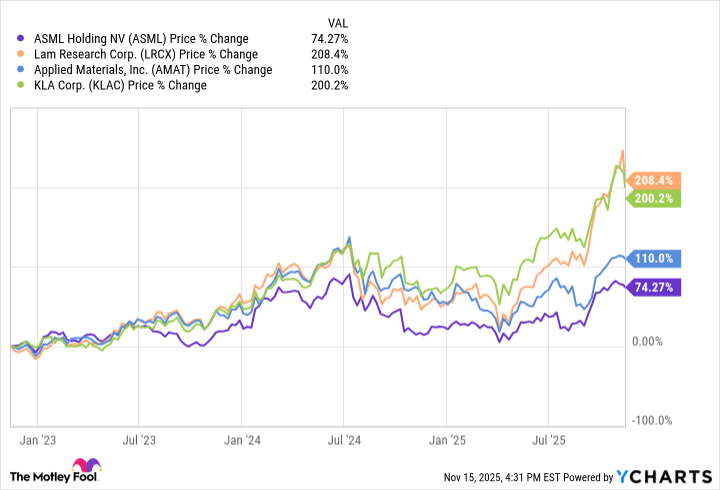As the artificial intelligence revolution has progressed, we've seen a number of associated tech companies split their stocks. However, one company which arguably holds the most dominant position among all AI stocks has yet to split its shares: ASML Holdings (ASML +1.29%).
With a share price exceeding $1,000 per share, the Netherlands-based maker of advanced lithography equipment could certainly split its shares, as its peers have done over the past few years. But will it?

NASDAQ: ASML
Key Data Points
Do stock splits make a difference?
It is worth noting that stock splits don't change the value of a company. If a stock splits two-to-one, its share price will be halved, but the number of shares will double, making no difference to the company's market cap or the value of current investors' holdings.
The track record for stocks that have split their shares is mixed. Stocks most ripe for a split are those that have outperformed, which usually indicates high-quality companies and therefore long-term outperformance. On the other hand, stocks that have appreciated significantly may also be overpriced, perhaps foretelling a sell-off. Usually, whether a stock has or has not split doesn't make much of a difference to the long-term performance.
It is true that in prior years, a lower share price brought on by a split has made a stock more accessible to small-dollar investors. Historically, that may have had a slight positive effect by opening up shares to more buyers.
But these days, most brokerages allow the buying and selling of fractional shares of stocks. Therefore, the additional buying effect of a lower stock price is lessened today, since retail investors can now buy half-shares or quarter-shares through most platforms.
ASML: The definitive leader
A split does, however signal confidence in the future, and hence the staying power and sustainability of the stock in question. ASML, as the definitive market leader in advanced lithography machines, certainly fits that bill. ASML's machines project extremely small-wavelength light through a photomask onto a wafer, essentially "drawing" the tiny transistor pattern onto a semiconductor wafer coated with photoresist chemicals.
As Moore's Law continues to push transistors closer and closer together in order to pack more power onto each piece of silicon, the light needed to draw these patterns has become finer and finer.
Chip designs have become so intricate that, starting around 2019, leading-edge chips required a technology called extreme ultraviolet lithography (EUV). The technology behind EUV is so complex that it required industrywide collaboration over two decades to perfect. EUV machines have the ability to create and capture light only 13.5nm wide, which is 5,000 times thinner than a human hair. Today, only ASML has the ability to provide EUV technology, making it a de facto monopoly within the semiconductor sector.
And there doesn't appear to be much competition on the horizon for ASML any time soon. EUV machines require 100,000 parts from several key sole suppliers, such as Zeiss glass and laser company Cymer, which ASML purchased in 2013, all of which must work in perfect harmony. With supplier collaboration all coming together under ASML and the incredible technical difficulty involved, ASML looks to have a commanding lead. This is especially true as ASML is now beginning to sell high-NA EUV machines, which use anamorphic lenses to compress the light wavelength down to just 8nm.

Image source: Getty Images.
Other semiconductor stocks have split their shares in recent years
If ASML were to split its stock, it would have illustrious company. GPU chipmaker Nvidia (NVDA 1.91%) executed a 10-for-1 stock split in June of 2024. Since the latest split, Nvidia has appreciated 57% as it continues to ride the AI investment wave.
But ASML is a semiconductor equipment stock, or, the machine that makes chips. Those stocks have also done well in recent years due to the AI buildout. One such peer is Lam Research (LRCX 0.41%), which makes etch and deposition machines that build conductive materials on the wafer based on the lithographic pattern.
Lam split its stock in 2024, in October, and like Nvidia, split its share price 10-for-1. Since Lam's split, its stock has appreciated an even greater 82%.
Can a stock-split lead to better performance?
Over the past three years, ASML has seen its stock appreciate 74%, not including dividends, which is certainly nothing to scoff at. However, that actually lagged other major semiconductor capital equipment players.
Is the underperformance due to a lack of a stock split? It's possible. But more likely it has to do with the fact that that ASML came into this period at a higher valuation than its peers, leaving the company to "work harder" to garner share price gains.
Still, given that management would certainly be justified in a split, as ASML has tremendous staying power, executing a stock split may be worth a shot at this point in time.
